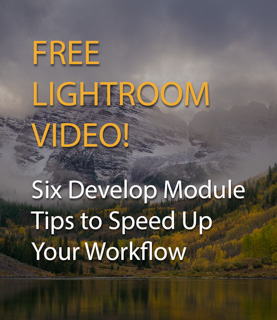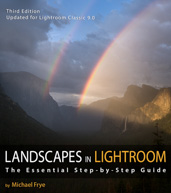In the Moment:
Michael Frye's Landscape Photography Blog
by Michael Frye | Dec 13, 2013 | Photography Tips, Yosemite Photo Conditions
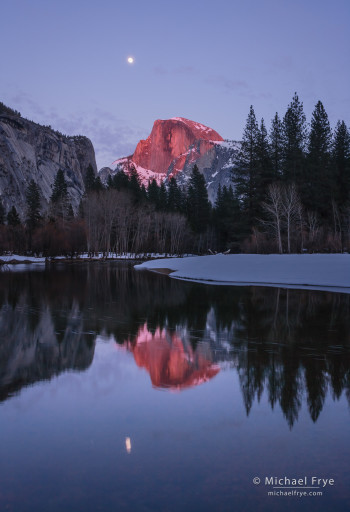
Half Dome and moon at sunset, February 18th, 2008
There’s something magical about the moon. Putting the moon in a photograph adds a sense of mystery and timelessness, and can elevate an otherwise ordinary scene into something special. Ansel Adams confessed to being “moonstruck,” and I suppose I am too.
The moon will be full next Tuesday (at 1:28 a.m. here on the west coast), and I’m sure many photographers will be trying to capture a rising or setting moon during the coming days, so I thought I would share some ideas about photographing the full moon, and clear up some misconceptions.
Misconception #1
One misconception is that moonrise or moonset photos are taken at night. They’re not: they’re almost invariably made near sunrise or sunset. After dark the contrast between the moon and the landscape is too great, and a good exposure for the moon will make the landscape completely black, while a good exposure for the landscape will wash out the moon. Around sunrise and sunset it’s possible to balance the light between the moon and the landscape and get detail in both, yet have a dark enough sky for the moon to stand out clearly.
Misconception #2
Another misconception is that moonrise or moonset photos are made on the date when your calendar says “full moon.” This can work if the terrain is flat, or you’re at a high vantage point. But if there are mountains or ridges blocking your view of the horizon, you’re better off photographing a moonrise one to three days before the full moon, and a moonset one to three days after the full moon. While the moon won’t technically be full, it will look full enough, and be in a better position than on the actual full moon night. Here’s why:
(more…)
by Michael Frye | Aug 16, 2013 | Reviews
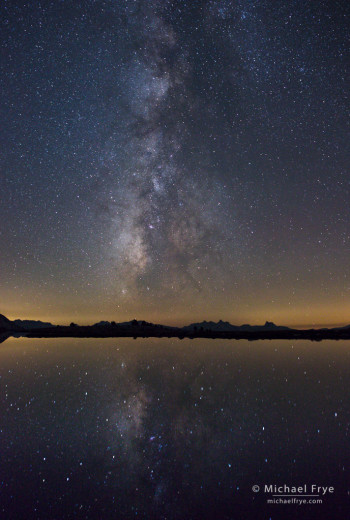
Milky Way reflected in an alpine lake, Yosemite NP, CA, USA. Nikon D800E with 24mm f/1.4 lens; 20 seconds, f/2.8, 6400 ISO
Regular readers of this blog know that I don’t often write about equipment. Equipment is necessary, and important, but not the most important thing in photography.
However, equipment does matter in some situations, like when trying to capture fast-moving subjects, or the faint light of stars, or when you want to make a large print that’s sharp and noise-free.
My regular camera is ancient by the fast-moving standards of the digital age. It’s a 16-megapixel Canon 1Ds Mark II, first introduced in 2004. I haven’t felt a compelling urge to upgrade. Newer models like the Canon 5D Mark II and Mark III have a little higher resolution (21 and 22 megapixels, respectively), but the difference isn’t that significant. They also handle noise better, but again, the advantages are relatively small.
One of the reasons I’ve been slow to upgrade to a new model is because while Canon has been making these modest improvements in image quality, Nikon has been making big leaps. For several years the Nikon sensors (some of which are made by Sony) have outclassed Canon in handling noise – something I could see clearly when looking at student’s photos during workshops. And last year’s introduction of the 36-megapixel Nikon D800 and D800E set a new standard for resolution in a 35mm-style DSLR. All this makes me think about switching, and hesitant to invest in more Canon equipment.
(more…)
by Michael Frye | Dec 31, 2012 | Announcements
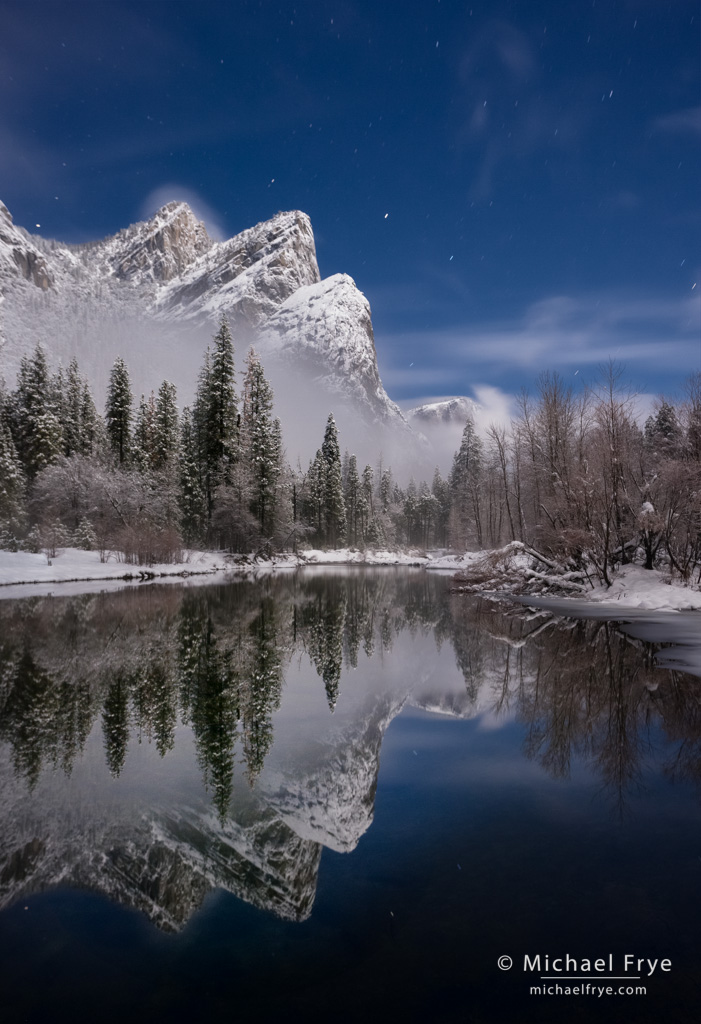
Three Brothers reflected in the Merced River on a moonlit night, Yosemite NP, CA, USA
It was 1985 — I think. My fiancé Claudia and I had started working at The Ansel Adams Gallery in Yosemite Valley in September. On New Year’s Eve it snowed, but after dark the storm broke, and a full moon appeared through rifts in the clouds.
Someone suggested going cross-country skiing in the moonlight. With a few co-workers from the gallery and other valley friends we gathered our ski equipment and headed out to the Ahwahnee Meadow. There were nine of us altogether (I only know that because a snapshot of the group has survived). Most of the group weren’t experienced skiers, and I remember a lot of flailing and falling while we were trying to cross a ditch in the meadow.
Then someone had the brilliant idea of skiing to Mirror Lake, about two miles away. In our youthful exuberance and folly we all thought this sounded great. We skied out past the Ahwahnee Hotel and along the old roads that lead to the lake. At one point Claudia, myself, and a few others got behind the rest of the group, only to be ambushed by snowballs as we entered a stand of trees.
We eventually made it to Mirror Lake around midnight. None of us thought to bring any champagne, but it didn’t matter — we were quite happy anyway, and thought it was a fitting way to greet the new year.
(more…)
by Michael Frye | Sep 27, 2012 | Advanced Techniques, Night Photography, Photography Tips
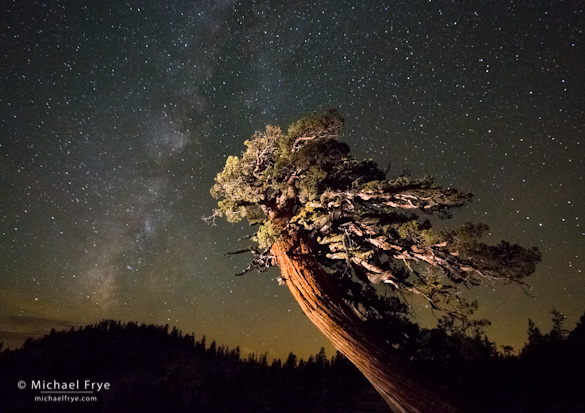
Sierra juniper and the Milky Way, Olmsted Point, Yosemite
Gear Doesn’t Matter—Except When it Does
Regular readers know that I’m not much of an equipment geek. It’s not that I don’t think equipment is important—a photographer needs good tools. It’s just that I think light, composition, technique, vision, and imagination are more important. In other words, how you use the tools is more important than what tools you use.
But sometimes the right gear can make a difference. Two weeks ago I was recording video segments for some online courses I’m working on (more about that later!), and needed a digital SLR that could record video—something my trusty old Canon 1Ds Mark II can’t do—for some “through-the-lens” views. So I called up my friend Jim Goldstein. Many of you know Jim through his popular blog and social media streams. Jim also works for Borrowlenses.com, and he set me up with a Canon 5D Mark III for my video shoot, and then asked, “Is there anything else you need?” Hmm… well I’ve been wanting to test the Canon 24mm f/1.4L lens for night photos, so yes, there was something else!
(more…)
by Michael Frye | Jun 26, 2012 | Vision and Creativity, Workshops
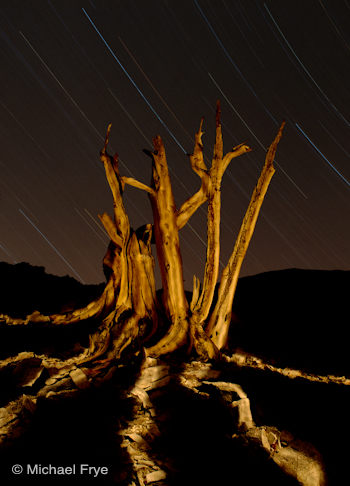
Bristlecone pine snag at night with star trails, White Mountains
Night photography offers wonderful opportunities to be creative. The low light allows you to use long exposures to record movement, like star trails or moonlit clouds. And since the natural light is so dim, you can easily overpower it with a flash or flashlight and add your own light to a scene.
That aspect of night photography—light-painting—has intrigued me for a long time. Adding your own light to a nighttime scene gives it a new dimension; it instantly transforms the landscape into something different, something we never see in real life, and adds a mysterious, surreal element to the photograph.
The accompanying image has both movement, in the form of star trails, and light-painting. I used a flashlight to trace the branches of this bristlecone pine snag, then painted zig-zag lines over the rocky foreground. I made this photograph with medium-format film back in September of 2000. Some test exposures with a Polaroid back helped me get the light-painting right, then I switched to real film (probably Provia), did the light-painting again, and then left the shutter open for another 90 minutes to record the star trails. You can see more examples of my light-painting techniques in my nighttime portfolio.
I learned light-painting with film, which was a slow trial-and-error (mostly error) process. Digital cameras make the learning curve much easier, because you can experiment and see the results immediately. If you’ve never tried night photography before this might be a fun summertime project—a way to stretch yourself a little and exercise your imagination. Summer is a great season for photographing landscapes at night, since the Milky Way is prominent, and the warm nighttime temperatures make it more comfortable to stay out late.
Whether you’re an experienced night photographer or a beginner, I recommend reading Lance Keimig and Scott Martin’s excellent book Night Photography: Finding Your Way in the Dark. Also, you can find tips about focus and exposure for moonlit landscapes in my post about photographing lunar rainbows.
And if you prefer hands-on learning there’s still space in my Full Moon Night Photography workshop later this summer (July 31st and August 1st). This is a great way to get personalized instruction and learn night photography in a fun, supportive group atmosphere. Rooms have been set aside for this workshop in Yosemite Valley and are still available if you register soon.
—Michael Frye
Related Posts: Under the Full Moon; Tips for Photographing Lunar Rainbows; Also, see images made by participants in last year’s night photography workshop in this Flickr group
Michael Frye is a professional photographer specializing in landscapes and nature. He is the author and photographer of The Photographer’s Guide to Yosemite, Yosemite Meditations, and Digital Landscape Photography: In the Footsteps of Ansel Adams and the Great Masters, plus the eBooks Light & Land: Landscapes in the Digital Darkroom, and Exposure for Outdoor Photography. He has written numerous magazine articles on the art and technique of photography, and his images have been published in over thirty countries around the world. Michael has lived either in or near Yosemite National Park since 1983, currently residing just outside the park in Mariposa, California.






